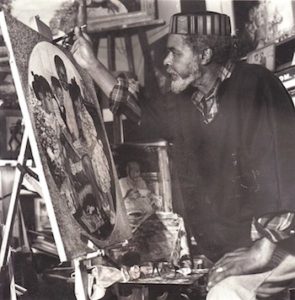
Eugene White
*Eugene E. White was born on this date in 1933. He is a Black artist.
White's roots are from Ozan, Arkansas, where many of his dreams were born. As a young boy, he grew up in the church, went rabbit hunting, harvested corn, picked berries, and worked in the cotton fields. At school at a very early age, White remembers being labeled as "odd and different" and recalls the folks around him commenting, "That boy has got a gift." But there were no classes during those early years of his school days that would be an accompaniment for the talent that he exhibited.
Yet it was in the 8th grade that he began a course in agriculture, which he felt was indirectly' a beginning for him. ' During the course, he drew the symbol for the N.F.A. (New Farmers of America), picturing an eagle, a plow, and a bowl of cotton. As the years passed and the thoughts of his childhood resurfaced, he says most assuredly that "the gift" mentioned above was and is "creative art."
In the late 1940s, Eugene left Arkansas on the back of one of his uncle's old trucks and headed north to the tomato harvest. After working in the tomato harvest in Adrian, Michigan, for a short time, he and a friend headed to Saginaw, where he painted signs there for a while when he could get the work. Soon he received information from home that he had relatives in Detroit where he worked at a clothing store exchange, a dairy and was hired at General Motors (Cadillac) Company.
While strengthening ties with his Detroit family and bonding with his new friends, he was experiencing racism on the job and didn't feel that he could share his feelings where he would be best understood from a Black man's perspective in America. White's inner soul was somewhat shattered because some of his relatives and friends failed to understand why he would jeopardize a "good job" and not go along with the program set up at Cadillac. He felt that there are times when a man has to take a stand and suffer the consequences of his actions, especially if that something is what they believe they should be doing at that moment in time. Eventually, he felt that it was time for him to move on.
White headed west and arrived in San Francisco in 1958. In San Francisco, he came to have a heightened awareness of his knowledge. This new knowledge enabled him to see his gains and where they led. He foresaw that it was no simple task to undergo. After taking ill, White continued drawing while in the hospital in 1963. He drew the nurses who were caring for him.
His family was constantly around him; his dad from Arkansas was at his side daily. He strongly feels that through their love and strength, he was able to recuperate from a near-death experience. After his release from the hospital, White began to draw again, this time as he had in his younger years. His reasons now were to show the dignity, strength, beauty, and inner feelings of his people and himself.
His first public art show, at the Hall of Rowers in Golden Gate Park with Bulart in San Francisco (1964), was an interpretation of his art. His show brought a response from the public, a new level of consciousness, a heightened sensitivity aroused by being in the midst of his people. White found that he did not have an art language verbally or academically. He did not have an art language from any institutional concept, and he was awakened to the response from the public.
White was then able to teach himself from the observations and comments directed at his works; he then began to learn from his people. White’s work is on view throughout the city, from portraits on walls of churches and community centers to simple retail signs, but his body of work, hundreds of paintings and drawings, has rarely been shown. Maintaining a studio and gallery for over 50 years in San Francisco, where he raised his family with his wife Lynnette, White wrote an autobiography, “Jabo’s Boy – Now His Manchild,” published in 2004. An expanded edition is in the works. In 2006, he received the Medallion for the City of Nashville, Arkansas. In 2013, he received a commendation from the San Francisco Appreciation Society.